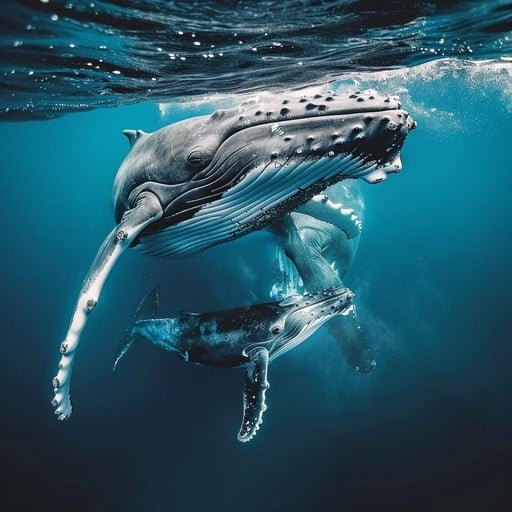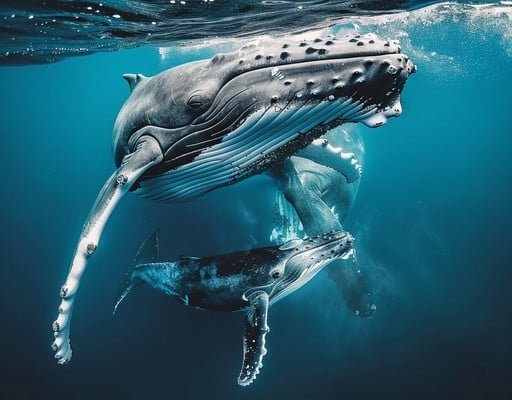
So, how do they do it? Understanding how humpback whales navigate and communicate is like unraveling a beautiful tapestry. Each thread of sound, movement, and instinct weaves together to reveal a sophisticated system that allows these whales to thrive in their aquatic world. Let’s dive deeper and explore how these magnificent creatures manage to find their way and talk to one another.
The Basics of Humpback Whale Navigation
First off, you might be wondering what makes humpback whales such savvy navigators. You see, humpbacks are known to migrate thousands of miles each year. They travel from their feeding grounds in colder waters to warm breeding waters, often covering distances of up to 16,000 miles. It’s like taking a road trip across several states, but they do it all in the ocean, which can make it tricky.
Humpback whales rely on a combination of strategies for navigation. One key factor is their *natural instinct*. They have an innate ability to perceive their surroundings and remember key landmarks. This helps them trace their routes during migrations. But they don’t just wing it. They also take advantage of the Earth’s magnetic field. Studies suggest that these whales can detect magnetic fields, using them as an invisible guide to help steer their course.
Another important aspect of their navigation is *the use of the sun and stars*. Humpbacks can orient themselves based on celestial bodies, much like sailors did centuries ago. They use these visual cues, combined with their internal compass, to remain on course, even in the vastness of the ocean.
How Humpback Whales Communicate
Communication among humpback whales is a fascinating topic. They have a unique way of “talking” to each other through a series of sounds, often referred to as *songs*. These songs are complex sequences of moans, grunts, and other vocalizations, which can last for up to 20 minutes.
So why do they sing? It’s believed that these songs serve multiple purposes. For one, they help establish social hierarchies, especially during mating season. Imagine it like a musical competition where the winner gets to attract a mate! The songs can also convey important information about food sources or alert others to potential dangers.
Interestingly, humpback whales have regional dialects. This means that whales from different groups can have distinct singing styles. It’s like how people from different parts of the world have their unique accents and phrases. Scientists have observed that these dialects can even change over time, as whales adapt and learn from each other.
Understanding Echolocation
Another fascinating element of humpback whale communication is *echolocation*. While not all whales use echolocation, humpbacks do have a sophisticated way of understanding their environment. Echolocation involves making sounds that bounce off objects in the water, helping the whales to “see” what’s around them, even in murky conditions.
Imagine playing a game of catch in a dark room. You can’t see the ball, but by listening for its sound as it bounces off the walls, you can catch it. That’s essentially what echolocation does for whales. They send out clicking sounds and listen for the echoes that return, allowing them to gauge the distance and size of objects nearby. This is incredibly useful for navigating through schools of fish or avoiding obstacles in the ocean.
Echolocation also plays a role in communication. Whales can convey messages underwater using specific clicks and whistles that other whales can interpret. This creates a layered communication system that not only helps them navigate but also fosters social connections.
The Role of Environments in Navigation
The ocean is a dynamic environment, and humpback whales are experts at adapting to it. They utilize different oceanic features, like currents, to assist in their navigation. These currents can carry them along their migratory routes, making their long journeys a bit easier.
You might think of these currents as highways in the ocean. Humpbacks can tap into them, conserving energy and making travel more efficient. They are finely attuned to the rhythm of the ocean and can detect the subtle changes in water temperature and salinity, which indicate different oceanic features.
Humpbacks are also influenced by the topography of the ocean floor. Underwater mountains, valleys, and other formations can guide their travel routes. It’s like how a hiker uses a map to navigate through mountains and valleys. Each feature serves as a point of reference that helps them find their way.
Challenges in Navigation and Communication
Despite their incredible abilities, humpback whales face challenges that can disrupt their navigation and communication. One major issue is noise pollution. Sounds from ships, underwater construction, and other human activities can drown out whale songs, making it difficult for them to communicate.
Imagine trying to hold a conversation in a crowded, loud café—it’s tough to hear your friends over the clatter of dishes and chatter of others. Similarly, increased noise levels can confuse whales, impacting their ability to find mates, locate food, or avoid danger.
Climate change is another factor affecting their navigation. Changes in ocean temperature can alter currents, which may mislead whales during their migrations. If the currents they rely on shift too dramatically, it can lead to longer travel times or even stranding on beaches.
Conservation And The Future of Humpback Whales
Given the challenges they face, conservation efforts are vital for the future of humpback whales. Protecting their habitats, reducing noise pollution, and addressing climate change are crucial steps to ensure these magnificent creatures can continue to thrive in our oceans.
Organizations are working to raise awareness about the importance of cleaner oceans and quieter shipping practices. By advocating for policies that protect marine life, we can help ensure that humpback whales maintain their incredible navigation and communication skills for generations to come.
Let’s not forget, every little bit helps. Even simple actions, like reducing plastic use or supporting eco-friendly initiatives, contribute to a healthier ocean. This not only benefits humpbacks but countless other marine species as well.
Humpback whales are truly fascinating creatures. Their unique methods of navigation and communication unveil a complex world beneath the waves. From their stunning songs to their remarkable navigational skills, these whales offer us a glimpse into ocean life that is both beautiful and intricate.
Understanding how humpback whales navigate and communicate is essential for appreciating their role in the ecosystem. As we learn more, we can take steps to protect these gentle giants and the environments they inhabit. After all, the ocean isn’t just their home; it’s ours too. So let’s work together to keep it vibrant and full of life.

